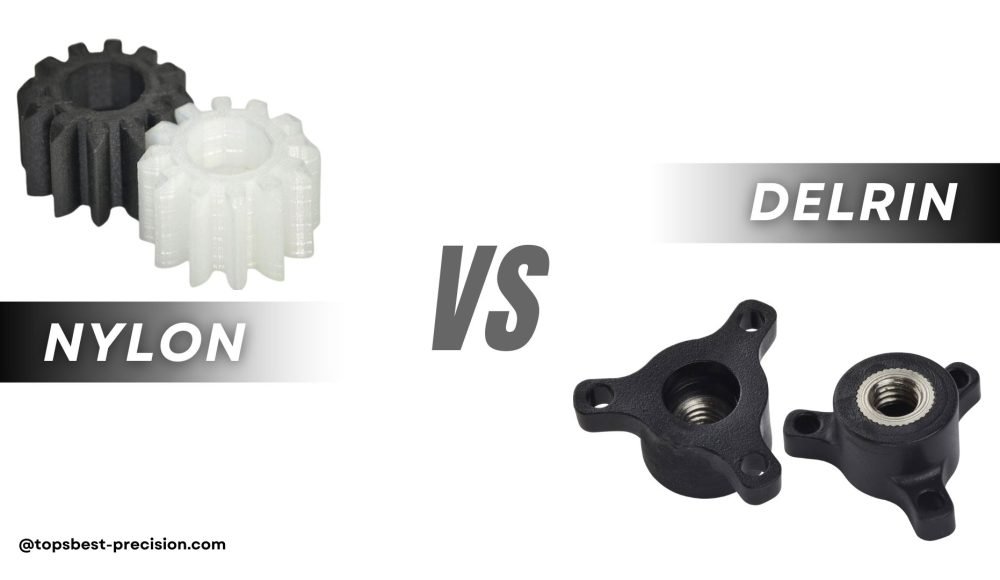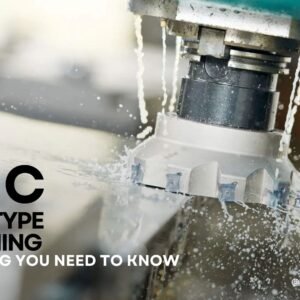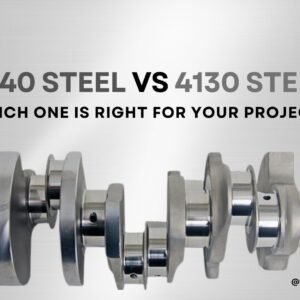Delrin e Nylon são os plásticos de engenharia mais frequentemente usados em usinagem e moldagem por injeção. Nylon é uma poliamida enquanto Delrin é um homopolímero de acetal. Os dois materiais têm características bastante marcantes. O nylon é quimicamente forte e resistente, proporcionando alta resistência à tração e é normalmente forte e duradouro. Delrin é famoso por sua excelente resistência ao desgaste.
Além do mais, ambos os materiais têm estabilidade UV bastante boa e são resistentes a produtos químicos tóxicos. Eles também apresentam um baixo coeficiente de atrito, o que é benéfico em várias aplicações. Engenheiros e designers devem comparar cuidadosamente Delrin e nylon. Este artigo irá guiá-lo na seleção do material certo para suas necessidades.
O que é náilon?
O nylon é um produto sintético de poliamida que resulta da polimerização por condensação. O processo utiliza ácidos dicarboxílicos e diaminas como monômeros. Sobre integridade estrutural, o náilon tem excelente resistência química e ao calor devido à sua base forte. No entanto, a absorção de umidade diminui a estabilidade do material. Estes problemas devem ser bem resolvidos através de tratamentos de pré-condicionamento para melhorar o seu desempenho..
O que é Delrin?
Delrin é um polímero de acetal. É cientificamente conhecido como polioximetileno ou POM. Devido às características descobertas, é mais adequado para uso em processos de usinagem e moldagem por injeção. Delrin vem com opções de homopolímero e copolímero.
Além disso, Delrin é um polímero semicristalino que possui alto grau de regularidade cristalina, o que confere ao material a sua característica cor branca opaca. Cores diferentes são possíveis para usos comerciais. Devido ao seu baixo atrito e alta rigidez, Delrin é ideal para uso em peças precisas.
Comparação direta entre Nylon e Delrin
| Propriedade | Nylon | Delrin |
| Resistência química | Altamente resistente a produtos químicos | Excelente resistência química e a solventes |
| Resistência à temperatura | Funciona entre 180°F e 190°F | Opera em temperaturas ligeiramente mais baixas |
| Absorção de umidade | Absorve até 8% umidade | Absorve apenas cerca de 0.2% umidade |
| Resistência à tracção | 12,000 psi | 10,000 psi |
| Maquinabilidade | Facilmente usinável, menos preciso | Excelente usinabilidade, alta estabilidade dimensional |
| Resistência ao desgaste | Melhor resistência ao desgaste em condições secas | Resistência ao desgaste ligeiramente inferior quando não preenchido |
| Propriedades de Fricção | Baixa resistência de contato | Baixa resistência de contato |
| 3Capacidades de impressão D | Compatível com vários métodos de impressão 3D | Requer preparação adicional para impressão 3D |
| Formulários | Usado em têxteis, automotivo, e engenharia | Preferido para peças de precisão como engrenagens e rolamentos |
Nylon e Delrin oferecem vantagens distintas para diversas aplicações de fabricação. Compreender suas propriedades ajudará você a escolher o material certo para as necessidades do seu projeto.
Benefícios & Desvantagens do Nylon vs.. Delrin:
Vantagens Delrin
- Design leve: Poucos materiais no mercado são mais leves que Delrin. Devido à sua alta densidade, mostra uma resistência à tração incrível e pode suportar facilmente choques e impactos.
- Excelente resistência à tração: A resistência à fadiga do Delrin é significativamente alta, tornando-o adequado para aplicações que exigem alto desempenho e durabilidade.
- Excelente usinabilidade: Delrin é fácil de processar com diferentes métodos de usinagem. Isto leva à fabricação precisa de componentes resistentes.
- Alta capacidade de estresse e deformação: Delrin tem um desempenho muito melhor que os metais quando se trata de estresse. Sua característica de retornar ao formato original após a deformação o torna ideal para uso em peças de encaixe e fivelas.
- Resistência à umidade: Delrin é um material ideal porque não absorve umidade. Isso o torna ótimo para áreas úmidas. Sua resistência química aumenta a durabilidade geral em vários processos de fabricação.
Limitações Delrin
- Resistência limitada à abrasão: Delrin pode não funcionar eficazmente em situações de alto atrito, o que pode limitar a sua aplicação em algumas aplicações industriais ou de construção.
- Baixa estabilidade térmica: Delrin tem uma temperatura de transição vítrea relativamente baixa e pode não ser ideal para aplicações de alta temperatura.
Vantagens do náilon
- Facilidade de Fabricação: Delrin pode ser tingido ou colorido facilmente, tornando-o uma opção mais personalizada para produzir peças precisas com tempo mínimo de entrega.
- Compatibilidade com impressão 3D: Nylon permite diferentes tipos de impressão. Por isso, permite a formação de padrões complexos, bem como formas complexas.
- Flexibilidade: O nylon é versátil por natureza.. Então, pode fornecer bons resultados em áreas que podem envolver flexão ou alongamento para oferecer boa resiliência em diversas condições.
- Propriedades de baixo atrito: Devido ao seu baixo coeficiente de atrito, o náilon é comumente usado em peças de produtos onde a operação é necessária com forças de atrito mínimas.
Desvantagens do náilon
- Usinabilidade desafiadora: O nylon não pode ser processado tão facilmente quanto a maioria dos materiais de alto desempenho, o que pode ser problemático durante o processamento.
- Sensibilidade à umidade: O nylon tem baixa resistência às características de absorção de umidade, o que pode reduzir sua funcionalidade e estabilidade em caso de exposição à umidade., especialmente em áreas de alta umidade.
Aplicações Delrin
Delrin encontra aplicação em inúmeras peças vitais em diferentes indústrias de manufatura. Aqui estão algumas aplicações comuns:
- Partes automotivas: Eles são encontrados nas engrenagens da janela, grelhadores, e peças de cinto de segurança do automóvel.
- Máquinas industriais: Integrado em equipamentos agrícolas, componentes do motor, rolamentos, e engrenagens de precisão.
- Dispositivos médicos: Uso em sistemas de administração de medicamentos e outros instrumentos médicos.
- Produtos de consumo: Aplicado em zíper, maçanetas de porta, e aplicações de válvulas.
- Componentes elétricos: Usado para o trocar, suporte de circuito, e outros invólucros de aparelhos elétricos.
Aplicações de náilon
O nylon é amplamente utilizado em vários setores porque é um material de alto desempenho. Aqui estão alguns usos:
- Ferragens de plástico: Especializada na produção de numerosos componentes plásticos para diversos setores.
- Componentes automotivos: Usado em algumas peças dos motores, engrenagens, e estruturas do carro.
- Utensílios de cozinha: O náilon é usado na fabricação de utensílios de cozinha e outros equipamentos de cozinha resistentes..
- Fixadores: Empregado ao fazer parafusos e porcas, entre outros fixadores.
- Engrenagens mecânicas: O nylon é utilizado em equipamentos de baixo peso, aplicações de alta resistência, como engrenagens e outros componentes de transmissão de energia.
Notas Delrin para prototipagem rápida
Delrin possui inúmeras classes para atender às demandas de prototipagem rápida. As notas comuns de Delrin incluem:
Delrin 150
Delrin 150 é o padrão para Delrin e é adequado para aplicações gerais. A usinabilidade é muito boa e possui alta precisão dimensional. Esta classe é perfeita para peças que precisam de precisão.
Delrin 511P
Delrin 511P também oferece maior estabilidade dimensional e melhor impacto, e força. É aplicado principalmente em motores onde a peça está muito desgastada.
Delrin 570
Delrin 570 é dotado de material reforçado com vidro para aumentar sua resistência. Possui alta rigidez e estabilidade dimensional quando submetido a altas deformações.
Delrin AF
Delrin AF é uma combinação de PTFE para baixo atrito e propriedades de desgaste aprimoradas. É ideal para ser usado em qualquer processo que envolva movimento suave ou baixos níveis de atrito. Esta classe é normalmente aplicada a engrenagens e rolamentos.
Classes de nylon para prototipagem rápida
Existem três dos graus mais comuns usados na prototipagem rápida, como segue.
Nylon 6
Nylon 6 é um homopolímero derivado da caprolactama de seis carbonos. Este grau tem uma cristalinidade mais baixa em comparação com os outros graus, portanto, é caracterizado por uma alta taxa de absorção de umidade..
Nylon 6,6
Nylon 6,6 é formulado por uma reação entre cloreto de adipoíla e hexametilenodiamina. É famoso por sua resiliência e possui uma ampla gama de estabilidade térmica e de umidade. O material também tem uma estabilidade muito boa em altas temperaturas.
Nylon 12
Nylon 12 é sintetizado pela polimerização de lactama láurica com unidades 12-metileno. É altamente resistente a impactos, inclusive em baixas temperaturas. Além disso, nylon 12 tem boa resistência a trincas e é relativamente durável o suficiente para produzir produtos altamente confiáveis.
Delrin vs.. Nylon: Como fazer a escolha certa?
A escolha entre Delrin ou Nylon normalmente depende dos requisitos específicos do projeto. Ambos os materiais apresentam características que os tornam adequados para diferentes aplicações. Escolher o caminho certo significa alcançar os melhores resultados em seu processo específico.
Delrin tem alta estabilidade dimensional, resistência ao impacto, e baixa absorção de umidade. Possui grande resistência química e permanece estável ao longo dos anos. Embora o náilon funcione perfeitamente sob fricção ou fricção. É ideal para aplicações que exigem peças duráveis, como engrenagens interligadas. Você apreciará quanto tempo dura, mesmo sob pressão ou condições extremas.
Delrin é mais forte que Nylon. Nylons têm 12000 resistência à tração psi enquanto Delrin implica 10000 resistência à tração psi. Cada material é vantajoso de diferentes maneiras, dependendo da natureza da operação do projeto em questão. Particularmente na modelagem de deposição fundida (FDM), as peças sofrem flexão extensa. Por esta razão, o material deve ser forte e elástico. Essas demandas são efetivamente, necessário no uso ativo, em oposição ao Delrin, que é mais frágil e pode não resistir bem a flexões repetidas.
Resumo
Nesta comparação detalhada, agora você pode considerar suas necessidades específicas. Conforme mencionado anteriormente, cada material se destaca em aplicações específicas. Selecionar o material adequado é muito importante para o seu trabalho. Também temos uma equipe de profissionais técnicos para fornecer excelente usinagem para materiais Delrin e nylon em Precisão máxima. Auxiliamos você desde a fase de aquisição da matéria-prima até a produção de qualquer peça. Contate-nos para um orçamento instantâneo, e responderemos a você dentro 12 horário comercial.
Perguntas frequentes
1º trimestre. Como distinguir Nylon vs Delrin pela força?
O nylon tem maior resistência à tração, sobre 12,000 psi, do que Delrin, que tem cerca de 10,000 psi. Isso torna o Nylon mais adequado para aplicações sob forte estresse do que o Delrin.
2º trimestre. Qual dos dois Nylon vs Delrin é mais ideal para altas temperaturas?
Nylon tem maior resistência à temperatura. Portanto, é mais apropriado para uso em altas temperaturas. Por mais que Delrin seja muito sensível ao calor, não é adequado para aplicações de alta temperatura.
3º trimestre. É possível usar Delrin em aplicações flexíveis?
Delrin tem boa estabilidade dimensional, mas não possui a flexibilidade do material Nylon. Para as aplicações, em que há necessidade de flexão contínua, O nylon é normalmente mais adequado.
4º trimestre. O Nylon é mais adequado para usinagem do que o Delrin??
Delrin é fácil de usinar porque mantém seu tamanho e possui alta resistência à tração.
Q5. Qual é uma comparação entre Nylon e Delrin na absorção de umidade?
Delrin absorve menos água, tornando-o ideal para ambientes úmidos. O nylon absorve umidade mais rapidamente do que o poliéster e isso pode afetar seu desempenho em ambientes relativamente úmidos.



